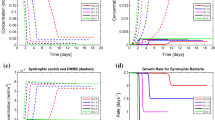Abstract
The synthetic chemostat model (SCM), originally developed to describe nonstationary growth under widely varying concentrations of the limiting substrate, was modified to account for the effects of nontrophic factors such as temperature and pH. The bacterium Geobacillus uralicus, isolated from an ultradeep well (4680 m), was grown at temperatures ranging from 40 to 75°C and at pH varying from 5 to 9. The biomass kinetics was reasonably well described by the SCM, including the phase of growth deceleration observed in the first hours after a change in the cultivation temperature. At an early stage of batch growth in a neutral or alkalescent medium, bacterial cells showed reversible attachment to the glass surface of the fermentation vessel. The temperature dependence of the maximum specific growth rate (μm) was fitted using the equation μm = A exp (λT )/{1 + expB[1 – C/(T + 273)]}, where A, λ, B, and C are constants. The maximum specific growth rate of 2.7 h–1 (generation time, 15.4 min) was attained on a complex nutrient medium (peptone and yeast extract) at 66.5°C and pH 7.5. On a synthetic mineral medium with glucose, the specific growth rate declined to 1.2 h–1, and the optimal temperature for growth decreased to 62.3°C.
Similar content being viewed by others
REFERENCES
Tansey, M.R. and Brock, T.D., Microbial Life at High Temperatures: Ecological Aspects, Microbial Life in Extreme Environments, Kushner, D.J., Ed., London: Academic, 1978. Translated under the title Zhizn' mikrobov v ekstremal'nykh usloviyakh, Moscow: Mir, 1981.
Lee, D., Koh, Y., Kim, B., Choi, H., Kim, D., Suhartono, M.T., and Pyun, Y., Isolation and Characterization of a Thermophilic Lipase from Bacillus thermoleovorans ID-1, FEMS Microbiol. Lett., 1999, vol. 179,no. 2, pp. 393-400.
Sharp, R.J. and Munster, M.J., Biotechnological Implications for Microorganisms from Extreme Environments, Microbes in Extreme Environments, Herbert, R.A. and Codd, G.A., Eds., London: Academic, 1981, pp. 216-218.
Loginova, L.G., Investigation of Thermophilic Microorganisms: Present State and Prospects, Biologiya termofil'nykh mikroorganizmov (Biology of Thermophilic Microorganisms), Moscow: Nauka, 1986, pp. 5-22.
Aleksandrov, V.Ya., Macromolecular Bases of Thermophily, Biologiya termofil'nykh mikroorganizmov (Biology of Thermophilic Microorganisms), Moscow: Nauka, 1986, pp. 57-63.
Nazina, T.N., Tourova, R.P., Poltaraus, A.B., Novikova, E.V., Grigorian, A.A., Ivanova, A.E., Lysenko, A.M., Petruniaka, V.V., Osipov, G.A., Belyaev, S.S., and Ivanov, M.V., Taxonomic Study of Aerobic Thermophilic Bacilli: Descriptions of Geobacillus subterraneus gen. nov., sp. nov. and Geobacillus uzenensis sp. nov. from Petroleum Reservoirs and Transfer of Bacillus stearothermophilus, Bacillus thermocatenulatus, Bacillus thermoleovorans. Bacillus kaustophilus, Bacillus thermoglucosidasius and Bacillus thermodenitrificans to Geobacillus as the New Combinations G. stearothermophilus, G. thermocatenulatus, G. thermoleovorans, G. kaustophilus, G. thermoglucosidasius and G. thermodenitrificans, Int. J. Syst. Evol. Microbiol., 2001, vol. 51, pp. 433-446.
Popova, N.A., Nikolaev, Yu.A., Tourova, T.P., Lysenko, A.M., Osipov, G.A., Verkhovtseva, N.V., and Panikov, N.S., Geobacillus uralicus, a New Species of Thermophilic Bacteria, Mikrobiologiya, 2002, vol. 71,no. 3, pp. 391-398.
Panikov, N.S., Kinetika rosta mikroorganizmov (Kinetics of Microbial Growth), Moscow: Nauka, 1991.
Nikolaev, Yu.A. and Prosser, J.I., Extracellular Factors Affecting the Adhesion of Pseudomonas fluorescens Cells to Glass Surfaces, Mikrobiologiya, 2000, vol. 69,no. 2, pp. 231-236.
Nikolaev, Yu.A. and Prosser, J.I., Some Properties of the Pseudomonas fluorescens Adhesin and Antiadhesin, Mikrobiologiya, 2000, vol. 69,no. 2, pp. 237-242.
Panikov, N.S., Microbial Growth Kinetics, London: Chapman and Hall, 1995.
Pirt, S.J., Principles of Microbe and Cell Cultivation Oxford: Blackwell, 1975.
Author information
Authors and Affiliations
Rights and permissions
About this article
Cite this article
Panikov, N.S., Popova, N.A., Dorofeev, A.G. et al. Growth of the Thermophilic Bacterium Geobacillus uralicus as a Function of Temperature and pH: An SCM-Based Kinetic Analysis. Microbiology 72, 277–284 (2003). https://doi.org/10.1023/A:1024239713941
Issue Date:
DOI: https://doi.org/10.1023/A:1024239713941




